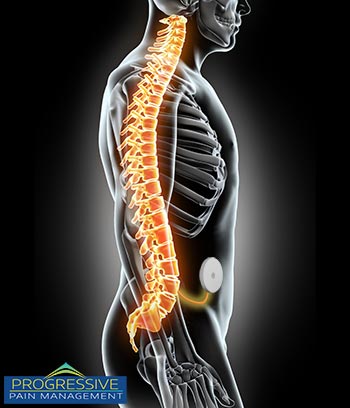100 adult patients suffering from chronic, severe nonmalignant pain were studied over the course of 12 months by Anjum Bux, MD, director of chronic pain management at Ephraim McDowell Regional Medical Center and Harrison Memorial Hospital in Danville and Cynthiana, Ky. The criteria for the 100 individuals required they have already undergone 6 months of conventional pain management prior to the introduction of an intrathecal pump.
What is an Intrathecal Pump and How Does it Help with Chronic Pain Management?

An intrathecal pump is implanted under the skin in that abdomen and delivers medication directly to the spine.
An intrathecal pump is a device that is used to deliver pain medication such as morphine, ziconotide and baclofen directly to the spinal cord. The small pump is surgically implanted beneath the skin, usually in the abdomen, and uses a catheter to deliver pain medication to the appropriate region.
Intrathecal pumps are often used to treat conditions such as chronic back pain, chronic neck pain or sciatica. Some patients suffering from failed back or neck surgery may also benefit through the use of an intrathecal pump for. The pump can often replace administration of oral opioid medications in chronic noncancer pain patients.
There are two main styles of intrathecal pumps – fixed rate and variable rate.
- Fixed rate pumps – mechanically operated and no battery required.
- Variable rate pumps – contain a battery and integrated circuitry which allow rate of delivery to be adjusted. Variable rate pumps may need to be replaced over time due to the use of a battery
Measuring the Effectiveness of Medication Delivery Via an Intrahelical Pump
![]() The study tracked a variety of primary outcomes:
The study tracked a variety of primary outcomes:
- Changes in mean visual analog scale (VAS) pain scores
- Morphine milligram equivalent usage
- Number of daily medications
- Number of daily narcotics
The following secondary outcomes were also tracked:
- Changes in the number of ER visits
- Non–health care–related visits
- Number of hospitalizations.
Results of Study Show Significant Benefits When Using Intrathecal Pump
Bux reported a significant drop in mean VAS scores in the 100 participants after switching to the use of an intrathecal pump. VAS scores dropped from 7.81 to 5.81 (P<0.001).
The study also showed a drastic change in the use of daily oral or transdermal morphine equivalents. These dropped from 57.89 to 2.91 mg (P<0.001). The number of pain medications consumed by the participants also dropped from 1.78 to 0.98 (P<0.001).
The secondary outcomes tracked in this study also supported the case for intrathecal pumps.
- Hospitalizations – 0.22 to zero (P<0.001)
- Non-pump-related clinic visits – 0.81 to 0.53
- ER visits – 0.69 to 0.54
Bux concluded that the use of an intrathecal pain pump led to better pain control, as well as decreases in amount of total medications, narcotics, pain medications and ER visits.
Are you a candidate?
 Do you think you or a loved one may be a candidate for an intrathecal pump for pain management? Contact Progressive Pain Management today. We have 3 offices located conveniently throughout New Jersey.
Do you think you or a loved one may be a candidate for an intrathecal pump for pain management? Contact Progressive Pain Management today. We have 3 offices located conveniently throughout New Jersey.
Ocean Township Pain Management
References:
painmedicinenews.com (Account required to read full article)

Endoscopic rhizotomy may be the key to your chronic back pain relief.
In a study published December 2014, a common treatment for back pain known as conventional fluoroscopically guided continuous radiofrequency (CRF) and pulsed radio frequency (PRF) is compared to an endoscopic visually guided method.
A specially designed cannula and endoscope were developed specifically for this visualized, surgically directed endoscopic technique. The instruments were designed ergonomically, to keep the image in focus while the endoscope scope is resting on the cannula.
The technique used in this study allows the doctor to ablate a larger area of the transverse process where the medial branch crosses to innervate the facet. Nerve ablation or transection can be confirmed via endoscopically guided visualization.
The Method used in This Chronic Back Pain Study
The efficacy of endoscopic rhizotomy was initially evaluated through a retrospective non randomized study of 50 patients (originally carried out in 2005). The requirements for patients to be candidates for the surgically directed endoscopic technique were as follows:
- Patient had lumbar spondylosis and facet arthrosis
- Patient experienced at least 50% pain relief by medial branch blocks
Cadavers aided in surgical technique refinement. Cadaver dissections showed variations in the locations of the dorsal ramus, including the medial branch. These anatomic variations clearly demonstrated the benefits of visualized rhizotomy
Once efficacy was demonstrated in this initial study, 400 more patients were added to this retrospective study by May 2013. It was at this time the inclusion requirements were boosted to a base of 75% estimated improvement. This was done to circumvent the variable subjectiveness of a 50% improvement threshold. This minimized the possibility a patient may be overestimating their initial response to treatment in hopes that they would qualify for the endoscopic guided procedure.
Endoscopic Rhizotomy Study Results
Patients were evaluated one year after the study design. All patients had VAS (visual analog scale for pain) improvement equal or greater than injection. The results of this chronic back pain study aligned with findings in additional surgical cases. Greater surgical exploration could be achieved by using visualized rhizotomy, resulting in a higher level of back pain relief for patients. Approximately 10 percent of the patients had mild recurrence of their back pain when following up one and two years later, but none to the original level of pain.
Continuous Radiofrequency (CRF) and Pulsed Radiofrequency (PRF) Study
CRF and PRF are common treatments for chronic back pain. While these methods are commonly used, even when successful, the relief provided by this form of treatment is usually temporary.
In 2005, a non-randomized retrospective study was carried out to assess the effect of endoscopic radiofrequency lesioning in 50 patients with chronic back pain. Patients were required to experience at least a 50% improvement in pain utilizing medial branch blocks to qualify for the study.
As time went on, the requirements to participate in the study became more stringent to further restrict the recommendation for surgical intervention. By 2013 the study size grew to 450.
Results of CRF / PRF Study
Out of the 50 original participants of the study, 10 percent partially regressed at the one-year follow-up, but none were worse. All patients were glad to receive the rhizotomy treatment, even if some of the pain relief had already begun to fade a year later. All patients experienced relief of back pain equal or greater than they had prior to the intervention, and some had relief of sciatica as well.
As time went on and treatment as given to the remaining 400 participants, the procedure evolved and became more effective. Further review of cadaver anatomy led to the second phase of the study, where inclusion criteria was adjusted to maximize the potential for positive results.
Conclusion
The results of those chronic back pain studies suggest that endoscopic rhizotomy targeting the variable dorsal ramus anatomy is more effective and provides longer lasting results than the traditional fluoroscopically guided procedures. The inclusion of an endoscope helped bridge the gap between open surgical procedures and traditional pain management techniques, while providing a minimally invasive surgical option to maximize the potential for longer lasting pain relief.
References:
You can learn more about these studies by visiting: https://www.ncbi.nlm.nih.gov/pmc/articles/PMC4325504/

